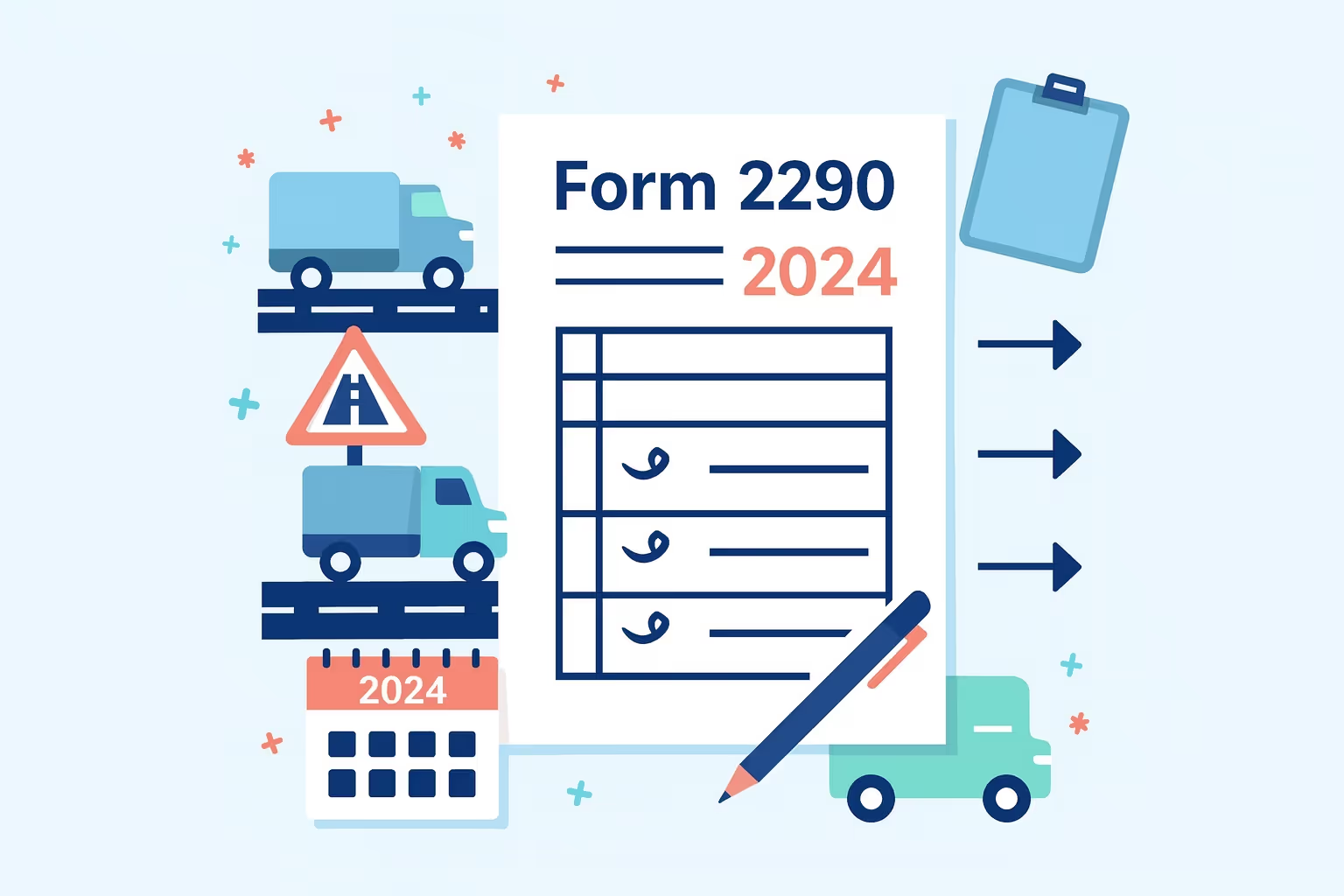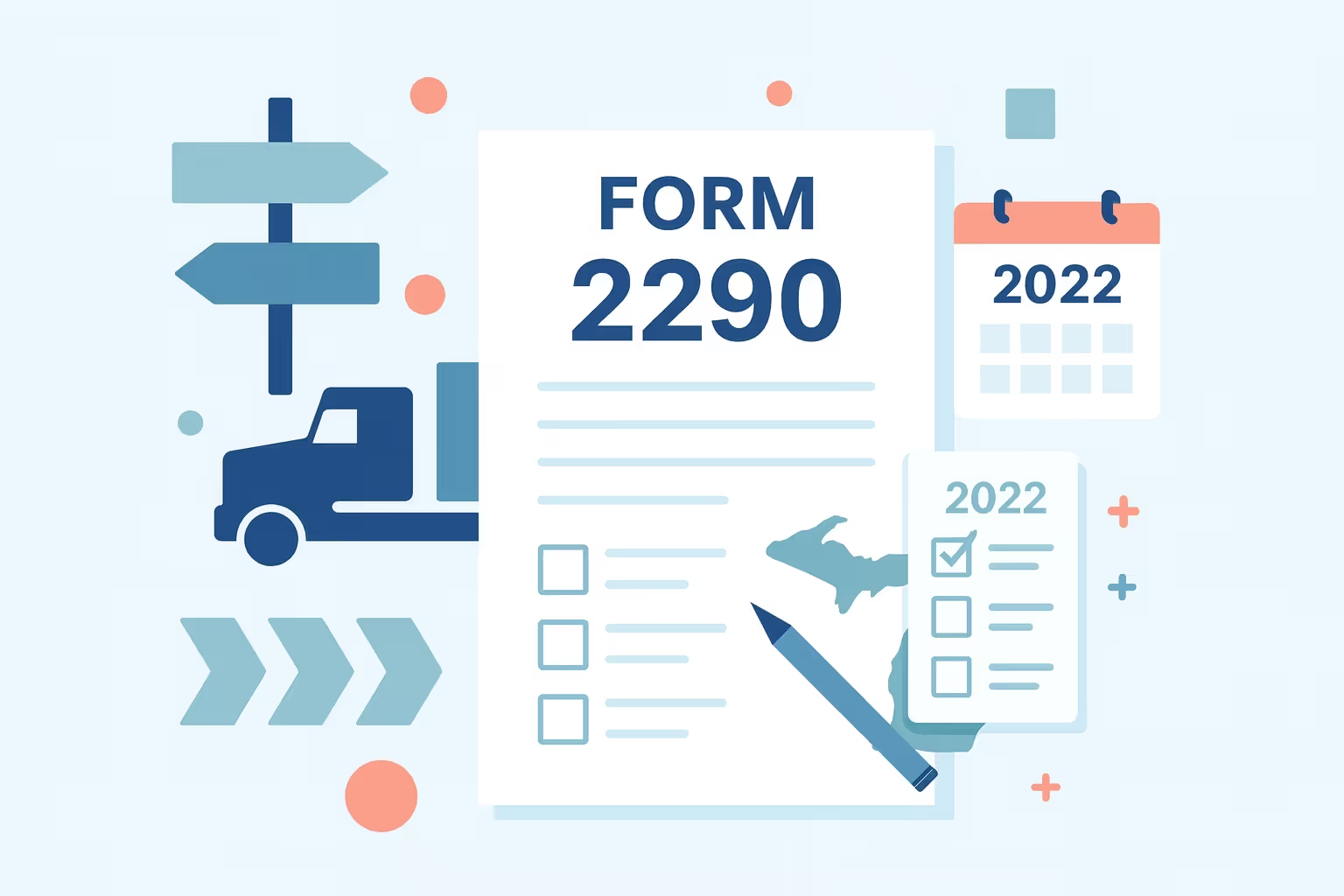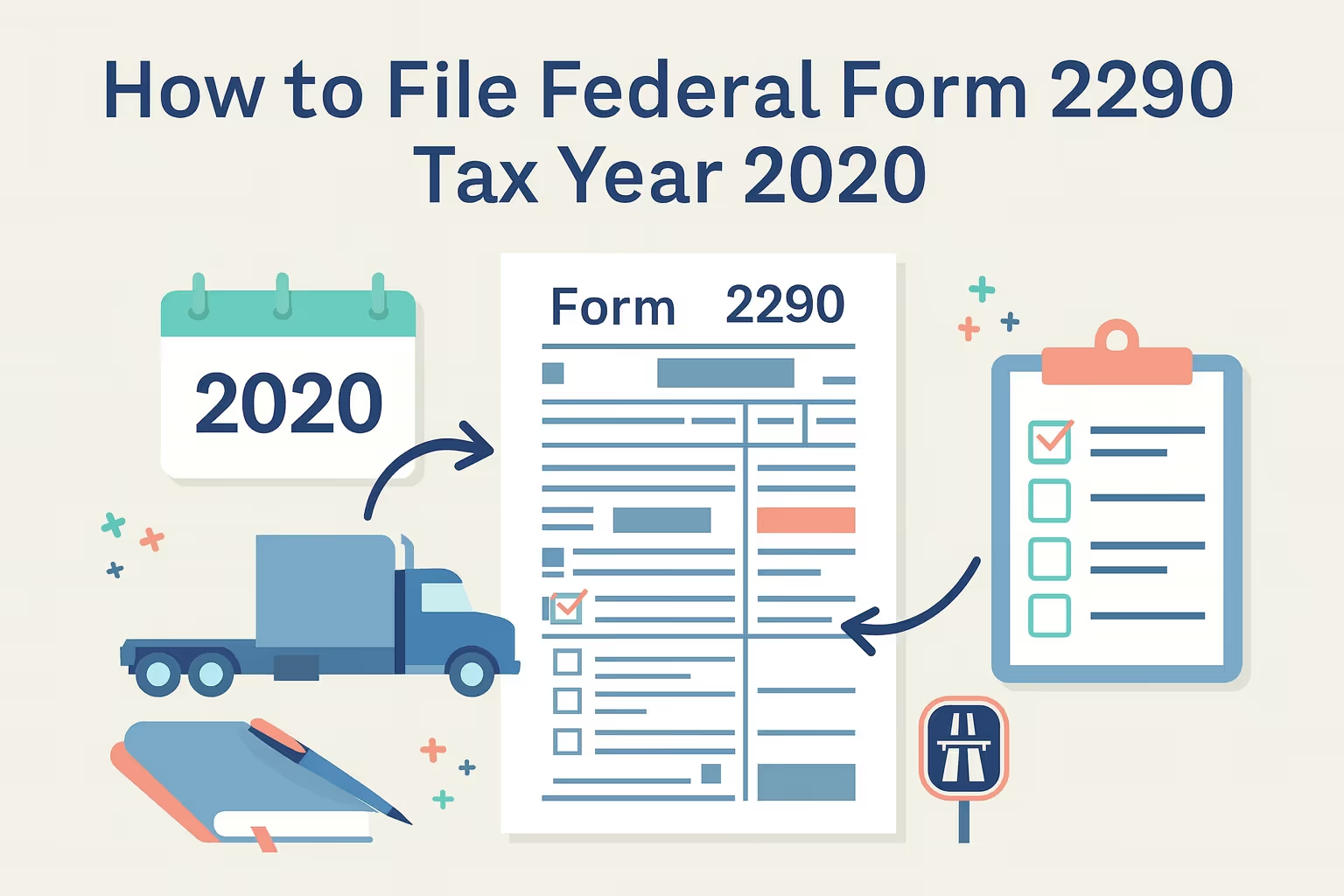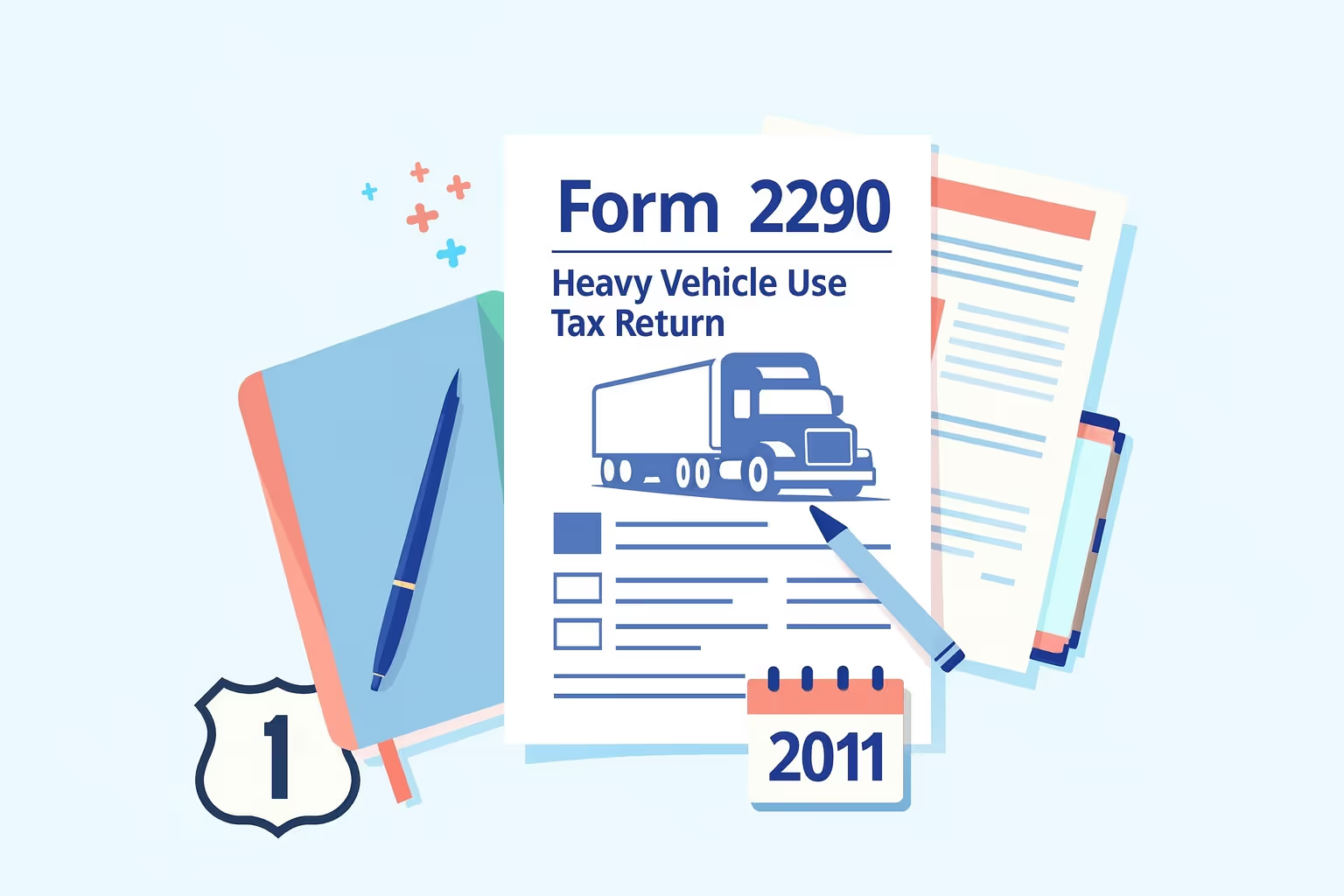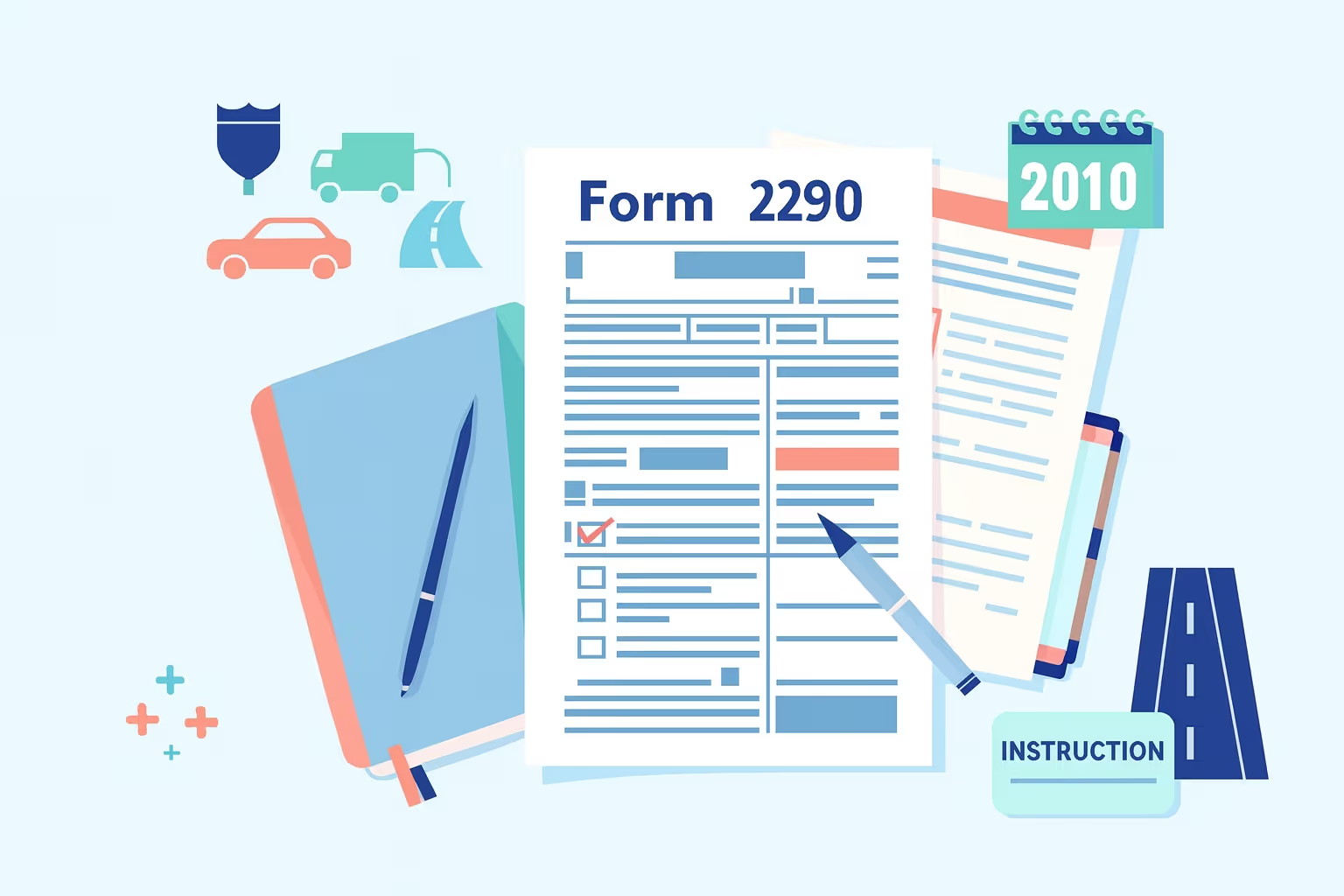Form 2290 2013 Instructions: IRS Heavy Vehicle Use Tax
The Internal Revenue Service collects the Heavy Highway Vehicle Use Tax each year to support the upkeep of public highways. Owners of highway motor vehicles with a gross weight of 55,000 pounds or more must complete Form 2290 Heavy for the 2013 filing period, which covers July 1, 2013, through June 30, 2014. This annual fee applies to taxable vehicles used for commercial transport, agricultural operations, and other qualified business purposes on federal highways.
Filing Form 2290 Heavy provides the Internal Revenue Service with details about each taxable vehicle, including its registered gross weights and mileage use limits. The filing serves as proof of tax paid through Schedule 1, which is required for annual vehicle registration. A vehicle becomes taxable once it begins operating on public highways, and owners must report each taxable vehicle acquired during the year to stay compliant with federal requirements.
The Heavy Highway Vehicle Use Tax also applies to specific categories, including agricultural vehicles, mobile machinery, and those performing essential tribal government functions. Entities such as Indian tribal governments and organizations conducting non-transportation functions may qualify for exemptions. For official guidance, review the Instructions for Form 2290 (Rev. July 2013) issued by the IRS.
Understanding IRS Form 2290 Requirements
The IRS uses Form 2290 Heavy to collect the Heavy Highway Vehicle Use Tax from owners of qualified vehicles. This section explains who is required to file, the filing conditions, the vehicles eligible for exemption, and the documentation requirements. Reviewing each element ensures accurate reporting and ongoing compliance with federal filing obligations.
Who Must File Form 2290 Heavy
- Owners of taxable vehicles must file Form 2290 when registering highway motor vehicles with a gross weight of 55,000 pounds or more.
- Operators on public highways must submit Form 2290 if they use vehicles designed for freight, construction, or passenger transport.
- Businesses and sole proprietors, including corporations, partnerships, and limited liability companies, must file if they own qualifying vehicles.
- Agricultural operators must file Form 2290 when their vehicles exceed the weight threshold for taxable use.
- Nonprofit and government entities must file if they operate taxable vehicles that are not exempt under federal law.
Filing Conditions
- The annual filing requirement applies to all qualifying highway vehicles from July 1, 2013, through June 30, 2014.
- The first use rule requires taxpayers to file by the last day of the month following the vehicle’s first use on public highways.
- Taxpayers must report each taxable vehicle acquired and used on public highways during the tax period.
- Vehicles traveling 5,000 miles or fewer, or 7,500 miles for agricultural use, may qualify for suspension if they stay within the mileage limit.
Vehicles Exempted or Subject to Special Treatment
- Federal, state, and local government vehicles are exempt when used solely for official purposes that do not involve transportation or travel.
- Indian tribal governments are exempt when their vehicles are used solely for essential tribal government functions.
- Ambulance associations may exclude vehicles used exclusively for emergency off-highway transportation.
- Non-transportation trailers are exempt from taxation if not registered for use on highways.
- Mobile machinery may qualify for exemption if it is explicitly designed for non-transportation tasks.
Required Documentation
- Each filer must provide a valid Employer Identification Number because Social Security Numbers are not accepted.
- Taxpayers must accurately enter the Vehicle Identification Number for every listed vehicle.
- Filers must report registered gross weights used to calculate the applicable tax amount and category.
Taxpayers should verify all details before submitting their return. A detailed review ensures compliance, reduces filing errors, and supports a smooth vehicle registration process across jurisdictions.
Filing and Payment Deadlines for Tax Year 2013
Understanding the filing and payment deadlines for Form 2290 Heavy helps taxpayers meet federal requirements on time. The Internal Revenue Service bases the Heavy Highway Vehicle Use Tax schedule on the vehicle’s first month of public highway use. Meeting these deadlines maintains registration continuity and ensures accurate reporting for each taxable vehicle.
Tax Period Coverage
The 2013 filing period applies to all highway motor vehicles used from July 1, 2013, through June 30, 2014. Every taxable vehicle acquired during this timeframe must appear on the return, regardless of whether it was newly purchased or transferred. The filing confirms the tax paid for the full or partial year, depending on when the vehicle first began operating.
Each taxable vehicle used on public highways must have its tax calculated from the month it enters service. A vehicle used for the first time in July 2013 requires payment for the entire period, while those entering later incur a prorated amount. Reporting exact start dates ensures each registered gross weight aligns with the correct tax category and annual fee.
Filing Deadlines
The due date falls on the last day of the month following the vehicle’s first use. For example, carriers placing a taxable vehicle into operation during July must file Form 2290 Heavy and pay the associated tax by August 31, 2013. If the deadline occurs on a weekend or federal holiday, the next business day becomes the filing date.
Taxpayers should file as early as possible to avoid delayed processing or interruptions to state registration. Submitting accurate returns and confirming payment in advance of the deadline supports consistent compliance across all operating jurisdictions.
Payment Confirmation and Proof of Tax Paid
The Internal Revenue Service accepts electronic payments, Electronic Federal Tax Payment System transactions, or mailed checks with a Form 2290-V voucher. Taxpayers should retain confirmation records, including bank receipts or canceled checks, to verify each transaction. This documentation verifies that the tax paid aligns with the figures entered on the return and supports subsequent registration renewals or credit claims.
Meeting each filing and payment deadline ensures compliance and reduces unnecessary correspondence with the IRS. Proactive recordkeeping and early submission ensure that all heavy vehicles operating during the tax period remain properly documented.
Step-by-Step Form 2290 Heavy Filing Process
Filing Form 2290 Heavy requires accuracy and organization to meet the Internal Revenue Service standards. The process applies to highway motor vehicles with a gross weight of 55,000 pounds or more operating on public highways. Each step ensures that the Heavy Highway Vehicle Use Tax is calculated accurately and that the stamped Schedule 1 is issued promptly.
Step 1: Gather Essential Information
Collect every detail before starting your return to avoid errors and missing data. Complete preparation ensures all taxable vehicles are reported correctly and helps taxpayers remain compliant throughout the filing period.
- Every filer must have a valid Employer Identification Number because Social Security Numbers are not accepted.
- Each vehicle must include an accurate Vehicle Identification Number that matches official registration.
- Registered gross weights equal to or greater than 55,000 pounds must be verified before filing.
- The first month of use for each taxable vehicle must be recorded to determine deadlines.
- Vehicles traveling fewer than 5,000 miles, or 7,500 miles for agricultural use, may qualify for suspension.
- Taxpayers must retain proof of payment, such as canceled checks or bank statements, for verification purposes.
Step 2: Calculate the Taxable Gross Weight
Taxpayers use the taxable gross weight calculation to determine the HVUT payment amount due for each vehicle. Use actual operating data rather than estimates to produce accurate figures for your tax form.
- The weight of the vehicle when fully equipped and fueled must be included in the total.
- The unloaded weight of trailers or non-transportation trailers customarily used must be taken into account.
- The maximum load typically carried on public highways must be added to the calculation.
- Any increase in a vehicle’s registered gross weight during the year must be reported promptly.
- Each vehicle falls into a designated weight category that determines the annual fee assessed.
Step 3: Determine the Vehicle’s First Use Month
Each return must reflect the exact month the vehicle first operated on public highways. The due date is the last day of the month following the month in which the first use occurred.
For example, vehicles beginning use in July require filing by August 31. Maintaining a record of first-use dates ensures proper reporting and prevents deadline confusion. Fleet owners acquiring taxable vehicles mid-year must include them in that month’s filing.
Step 4: Complete the Header and Identification Details
The header provides business and identification data recognized by the Internal Revenue Service. Entering precise information helps avoid rejection or extended processing times.
Include your legal business name, complete address, and EIN exactly as registered. Check the “Address Change” box if your location has been updated since the last filing. Confirm that every detail matches IRS records to support acceptance without requiring corrections.
Step 5: Figure the Tax Due
The IRS tax computation tables determine the fee owed for each taxable vehicle. Reference the official Form 2290 (Rev. July 2013) to find the applicable rate.
- All taxable vehicles must be listed with Vehicle Identification Numbers and accurate weight categories.
- Exempt vehicles performing essential tribal government functions or those used for off-highway transportation should be excluded.
- Credit claims must reflect vehicles sold, destroyed, or stolen during the filing period.
- Registered gross weights equal to each listed category must align with the calculated HVUT payment.
Step 6: Prepare and Attach Schedule 1
Schedule 1 serves as proof of tax paid and is required for state registration. Two copies must be filed so that one can be stamped and returned. Review all listed VINs and categories thoroughly before submission to prevent processing delays.
Ensure all VINs, vehicle categories, and operational details are accurate. Maintain the stamped Schedule 1 and all related business records for three years. State agencies may require it to renew registration or verify compliance.
Step 7: Review, Sign, and Submit the Form
A complete review guarantees that every section of the form is accurate and consistent. Sign the return with an authorized signature and include all schedules and payment details. Verify each entry to ensure all figures and attachments match your records.
Select either electronic filing or paper submission depending on your preference and vehicle count. Keep digital and printed copies of the stamped Schedule 1 and payment receipts for reference. Comprehensive documentation supports a smooth filing process and timely acceptance by the IRS.
E-Filing and Payment Methods for Heavy Vehicles
Electronic filing offers a reliable and efficient way to submit Form 2290 Heavy to the Internal Revenue Service. The e-filing process reduces errors, accelerates confirmation, and ensures quicker access to a stamped Schedule 1. While paper filing remains an option for smaller fleets, electronic submission offers greater convenience and efficiency for carriers reporting multiple taxable vehicles.
E-filing is mandatory for taxpayers reporting 25 or more heavy vehicles operating on public highways. Each filer must use an IRS-approved service provider capable of transmitting data securely. The system automatically validates VINs, taxable weights, and HVUT payment details before submission, preventing rejection and minimizing the need for corrections.
Taxpayers who choose electronic filing benefit from immediate acknowledgment and easier record management. Electronic copies of stamped schedules, payment confirmations, and receipts simplify compliance tracking and recordkeeping. The process allows quick updates to reflect weight increases, mileage adjustments, or newly acquired taxable vehicles during the year.
Steps for E-Filing Form 2290 Heavy
- Each filer must select an IRS-authorized e-file provider that offers secure submission and full system support.
- Every taxpayer must create an account and verify their Employer Identification Number before filing electronically.
- All VINs, first-use months, and registered gross weights equal to the appropriate categories must be entered accurately.
- Each HVUT payment must match the calculated total for every taxable vehicle reported on the form.
- Every filer must authorize electronic payment, sign digitally, and confirm the return is ready for transmission.
- Taxpayers must download and securely store the stamped Schedule 1 after receiving acknowledgment of tax paid.
The e-filing platform automatically checks every field, minimizing errors and ensuring data integrity. Taxpayers receive a digital acknowledgment within minutes of acceptance, allowing for the immediate continuation of state registration or record updates.
Accepted Payment Methods
Taxpayers can select from several approved payment options when submitting their Heavy Highway Vehicle Use Tax:
- Electronic Funds Withdrawal allows direct payment through the e-file system using valid routing and account numbers.
- The Electronic Federal Tax Payment System (EFTPS) enables filers to schedule HVUT payments in advance through their registered account.
- Check or money order payments must be submitted with Form 2290-V and mailed to the designated IRS processing address.
All payments must match the total HVUT figure reported on Form 2290, Heavy Vehicle Use Tax. Filers must include their EIN and tax period on every transaction to ensure accurate posting. Proof of payment, such as canceled checks, EFTPS confirmations, or bank records, should be retained for a minimum of three years.
EFTPS transactions must be initiated at least one business day before the filing deadline. Direct debit payments offer same-day confirmation, while check submissions require additional mailing time. Selecting the most efficient option ensures timely processing and compliance with Internal Revenue Service regulations.
Using electronic filing and authorized payment methods supports secure transactions, accurate reporting, and timely issuance of Schedule 1. Completing both steps on time strengthens compliance and supports smooth fleet operations throughout the tax year.
Heavy Highway Vehicle Use Exemptions and Suspensions
Certain heavy vehicles operating on public highways may qualify for exemptions or suspensions from the Heavy Highway Vehicle Use Tax. These provisions apply to specific mileage thresholds, ownership classifications, and operational purposes. Understanding each eligibility type ensures accurate reporting and prevents unnecessary HVUT payments.
- Commercial Vehicles Traveling Fewer Miles: Vehicles operated 5,000 miles or fewer during the tax year may qualify for suspension. Filers must complete Form 2290 Heavy, check the suspension box, and list each vehicle under Category W on Schedule 1. Mileage logs must confirm that total use remained within the mileage limit.
- Agricultural Vehicles: Vehicles primarily used for farming operations can qualify for suspension if they travel 7,500 miles or fewer within the tax period. Each agricultural vehicle must be registered under state agricultural use laws. Consistent mileage records support ongoing eligibility and future compliance.
- Federal Government and State-Owned Vehicles: Vehicles owned and operated exclusively by the federal government, state governments, or local municipalities are exempt from HVUT. These units must serve official functions related to transportation, safety, or infrastructure maintenance.
- Indian Tribal Governments: Vehicles registered to Indian tribal governments are exempt when used solely for essential tribal government functions. Activities must provide public benefit rather than commercial gain. Supporting documentation should verify the qualifying service.
- Nonprofit Volunteer Fire Departments and Ambulance Associations: Vehicles operated by nonprofit organizations, including ambulance associations, volunteer fire departments, and rescue squads, are excluded from HVUT. Their operations must focus on emergency response and community safety.
- Mobile Machinery and Non-Transportation Trailers: Vehicles specifically designed for non-transportation functions, such as cranes or drilling equipment, are exempt from the tax. Non-transportation trailers that do not carry passengers or property on highways are also excluded.
- Suspended Vehicles Sold, Stolen, or Destroyed: Taxpayers can claim credits or adjustments for vehicles sold, stolen, or destroyed before the tax period ends. Proof, such as a sales bill or police report, must accompany the credit claim. The purchaser becomes responsible for HVUT reporting if the vehicle resumes taxable use.
Identifying applicable exemptions and suspensions ensures that filings accurately reflect the operational status of all vehicles. Proper documentation and recordkeeping confirm compliance and safeguard against unnecessary HVUT assessments. For additional clarification on exemption and suspension qualifications, consult the IRS FAQs for Truckers Who E-File.
Common Mistakes and How to Avoid Them
Accurate completion of Form 2290 Heavy ensures that every taxable vehicle is correctly reported to the Internal Revenue Service. Many common issues result from incomplete data, inaccurate weights, or missed deadlines. Reviewing frequent filing mistakes helps taxpayers avoid rejections, delays, and unnecessary correspondence with the IRS.
- Taxpayers often use a Social Security Number instead of an Employer Identification Number, which the IRS does not accept for Form 2290 Heavy filings. New EINs must remain active for several weeks before they can be submitted electronically. Applying early and confirming activation helps prevent e-file rejections and delays in receiving Schedule 1.
- Vehicle Identification Numbers often contain errors, such as transposed or missing digits, which can result in rejections or amended filings. Each VIN must match the one shown on the vehicle’s state registration. Verifying all VINs before filing ensures the IRS can process the return correctly.
- Many filers miscalculate registered gross weights of 55,000 pounds or greater when determining the HVUT payment. The total must include the unloaded vehicle weight, trailer weight, and maximum load typically carried. Inaccurate weights can result in incorrect payments and necessitate future amendments.
- Some operators misapply mileage use limits when claiming suspension for commercial or agricultural vehicles. Suspended commercial units must remain under 5,000 miles, and agricultural vehicles must stay under 7,500 miles during the tax period. Accurate mileage logs confirm compliance if the IRS reviews the account.
- Late filings and missed payments frequently lead to delayed Schedule 1 issuance and potential interest assessments. Tracking deadlines for each taxable vehicle and filing early ensures timely acknowledgment and uninterrupted registration. Filing early also allows for the correction of potential errors.
- Insufficient recordkeeping causes challenges during audits and credit claims for vehicles that have been sold, stolen, or destroyed. Taxpayers should retain stamped schedules, canceled checks, and payment confirmations for a minimum of three years. Complete records verify compliance and support requests for credits or refunds.
Verifying each entry before submission ensures accuracy and smooth processing. Careful attention to detail helps taxpayers remain compliant and receive prompt acknowledgment of HVUT payment.
Recordkeeping and Proof of Payment
Accurate documentation is essential for confirming compliance with the Heavy Highway Vehicle Use Tax. Every taxpayer must maintain clear records of payments, vehicle details, and supporting schedules for each taxable vehicle acquired during the period. Organized files help verify HVUT payment during audits and streamline future filings.
Recordkeeping Requirements
- Recordkeeping involves storing documents that show the Internal Revenue Service accepted the tax form, acknowledged payment, and stamped Schedule 1.
- Required materials include the stamped Schedule 1, a canceled check or bank confirmation, and a vehicle registration showing a gross weight of 55,000 pounds or more.
- Retaining these items for at least three years ensures proof of timely compliance with IRS rules and supports accurate reporting for each taxable vehicle.
Proof of Payment Essentials
- Proof of payment includes all documentation that validates the tax paid for heavy vehicles operating on public highways.
- Taxpayers should keep both electronic and physical records, such as e-file acknowledgment receipts, printed copies of stamped Schedule 1, and proof of canceled checks or EFTPS confirmations.
- These materials confirm the HVUT payment and allow owners to present evidence during registration renewals or federal reviews.
Best Practices for Record Management
- Effective record organization prevents disputes and helps taxpayers claim credits for vehicles sold, stolen, or destroyed before the end of the tax year.
- Each record should match the reported taxable vehicle, including Vehicle Identification Number, weight category, and mileage use limit.
- Maintaining separate files for commercial vehicles, agricultural vehicles, and exempted vehicles simplifies verification if the IRS requests supporting data.
Well-kept records demonstrate responsibility and preparation. Consistent documentation provides security for owners of highway motor vehicles and ensures all tax obligations remain verifiable.
Frequently Asked Questions
What is the purpose of filing a Highway Vehicle Use Tax return?
Filing a highway vehicle use tax return ensures that owners of heavy vehicles operating on public highways meet federal requirements. This annual filing records details such as taxable gross weight, usage period, and vehicle identification. Completing the tax return also secures a stamped Schedule 1, which serves as proof of tax paid. Without filing the vehicle use tax return, vehicle registration renewals may be delayed or denied by state agencies.
How does the Internal Revenue Service classify a taxable vehicle?
The Internal Revenue Service defines a taxable vehicle as any highway motor vehicle with a registered gross weight equal to or exceeding 55,000 pounds. These vehicles include trucks, truck tractors, and buses, primarily used on public highways. Vehicles specifically designed for off-highway transportation or mobile machinery may qualify for exemptions. Each taxpayer must report acquisition dates and details to ensure accurate category assignment and proper payment under the vehicle use tax return.
When is electronic filing required for the Form 2290 tax return?
Electronic filing is required when reporting 25 or more vehicles under the Heavy Highway Vehicle Use Tax. Even for smaller fleets, e-filing provides faster processing and immediate confirmation of payment. Through electronic filing, taxpayers receive a stamped Schedule 1 quickly, which simplifies the registration renewal process. The IRS recommends that filers use electronic systems to minimize errors, reduce paperwork, and update records for vehicles reported in a new category or suspension statement.
What is a suspension statement, and who must file it?
A suspension statement applies when a vehicle is expected to operate below the mileage use limit set for the tax year. Owners must check the suspension box in Part II of Form 2290 to declare limited highway use. This statement allows qualifying vehicles, such as certain agricultural vehicles or commercial vehicles traveling fewer than 5,000 miles, to avoid paying tax while maintaining compliance with the tax requirements. Taxpayers must maintain accurate mileage records to support their suspension claim.
How should vehicle owners report the acquisition of a used taxable vehicle?
Owners must report the acquisition of a used taxable vehicle if it is purchased and operated during the current tax period. The vehicle’s tax liability begins in the month of first use on public highways. Filers should complete Form 2290 for that month and calculate the partial tax based on the start date of the tax period. Including the correct category, weight, and VIN ensures accurate reporting and prevents classification errors in the highway vehicle use tax record.
What happens if a vehicle moves into a new category during the tax year?
If a vehicle increases in weight or changes use during the year, it may fall into a new category with a higher tax rate. The owner must file an amended return and pay additional tax for the remainder of the period. Reporting changes promptly helps maintain compliance with the Internal Revenue Service. Failure to update category information could result in registration issues or incorrect tax assessments during record review.
How can taxpayers correct errors after submitting their Form 2290?
Taxpayers who discover mistakes, such as incorrect VINs or weight categories, must file an amended Form 2290. The updated tax return should include corrected information and relevant supporting documents. If the change affects payment, additional tax may be required. Accurate corrections maintain proper records with the Internal Revenue Service and prevent delays in receiving the stamped Schedule 1. Amended filings also ensure alignment between reported details and registration requirements.
















